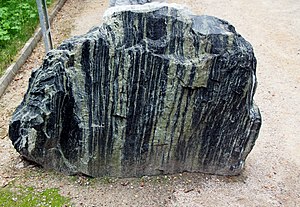Amphibolite
| Metamorphic rock | |
 An amphibolite boulder in the Botanical Gardens of Charles University, Prague, Czech Republic. | |
| Composition | |
|---|---|
| Amphiboles, such as hornblende and actinolite, often with plagioclase. | |
| Physical Characteristics | |
| Fabric | Schistose |
| Relationships | |
| Protoliths | Mafics, such asbasalt |


Amphibolite(/æmˈfɪbəlaɪt/) is ametamorphic rockthat containsamphibole,especiallyhornblendeandactinolite,as well asplagioclasefeldspar,but with little or noquartz.It is typically dark-colored and dense, with a weakly foliated orschistose(flaky) structure. The small flakes of black and white in the rock often give it a salt-and-pepper appearance.
Amphibolite frequently forms bymetamorphismofmaficigneous rocks, such asbasalt.However, because metamorphism creates minerals entirely based upon the chemistry of theprotolith,certain 'dirtymarls' and volcanic sediments may also metamorphose to an amphibolite assemblage. Deposits containingdolomiteandsideritealso readily yield amphibolite (tremolite-schist,grunerite-schist, and others) especially where there has been a certain amount ofcontact metamorphismby adjacentgraniticmasses. Metamorphosed basalt (metabasalt) createsortho-amphiboliteand other chemically appropriate lithologies createpara-amphibolite.
Although tremolite is a metamorphic amphibole, it is most commonly derived from highly metamorphosedultramafic rocks,and thus tremolite-talc schist is not generally considered a variety of amphibolite. Aholocrystallineplutonicigneous rockcomposed primarily of hornblende amphibole is called ahornblendite,which is usually a crystalcumulate rock.Igneous rocks with greater than 90% amphiboles, which have afeldspargroundmass,may belamprophyres.
Ortho-amphibolite vs. para-amphibolite
[edit]Metamorphic rocks composed primarily ofamphibole,plagioclase,with subordinateepidote,zoisite,chlorite,quartz,titanite,and accessoryleucoxene,ilmeniteandmagnetitewhich have aprotolithof an igneous rock are known asortho-amphibolite.
Para-amphibolitewill generally have the same equilibrium mineral assemblage as ortho-amphibolite, with more biotite, and may include more quartz, plagioclase, and depending on the protolith, morecalcite/aragoniteandwollastonite.
Often the easiest way to determine the true nature of an amphibolite is to inspect its field relationships; especially whether it is interfingered with other metasedimentary rocks, especiallygreywackeand other poorly sorted sedimentary rocks. If the amphibolite appears to transgress apparent protolith bedding surfaces it is an ortho-amphibolite, as this suggests it was adyke.Picking asilland thin metamorphosedlavaflows may be more troublesome.
Thereafter, whole rock geochemistry will suitably identify ortho- from para-amphibolite.
The wordmetabasaltwas thus coined, largely to avoid the confusion between ortho-amphibolite and para-amphibolite. This term is recommended by theBritish Geological Surveywhen it is possible to determine the origin of the rock from its characteristics alone (and not from field relationships), particularly when the degree of metamorphism is low.[1]
Amphibolite facies
[edit]

Amphibolite as a rock defines a particular set of temperature and pressure conditions known as theamphibolite facies.However, caution must be applied here before embarking on metamorphic mapping based on amphibolite alone.
First, for an ortho-amphibolite or amphibolite to be classed as a metamorphic amphibolite, it must be certain that the amphibole in the rock is aprogrademetamorphic product, and not a retrograde metamorphic product. For instance,actinoliteamphibole is a common product of retrograde metamorphism of metabasalt at (upper)greenschistfacies conditions. Often, this will take on the crystal form and habit of the original protolith assemblage; actinolite pseudomorphically replacingpyroxeneis an indication that the amphibolite may not represent a peak metamorphic grade in the amphibolite facies. Actinolite schist is often the result ofhydrothermal alterationormetasomatism,and thus may not, necessarily, be a good indicator of metamorphic conditions when taken in isolation.
Second, the microstructure and crystal size of the rock must be appropriate. Amphibolite facies conditions are experienced at temperatures in excess of 500 °C and pressures less than 1.2 GPa, well within the ductile deformation field.Gneissictexture may occur nearby, if not thenmylonitezones,foliationsand ductile behaviour, including stretching lineations may occur.
While it is not impossible to have remnant protolith mineralogy, this is rare. More common is to findphenocrystsof pyroxene,olivine,plagioclaseand even magmatic amphibole such aspargasiterhombohedra, pseudomorphed byhornblendeamphibole. Original magmatic textures, especially crude magmatic layering inlayered intrusions,is often preserved.
Amphibolite facies equilibrium mineral assemblages of various protolith rock types consist of:
- Basalt ortho-amphibolite; hornblende/actinolite +/- albite +/- biotite +/- quartz +/- accessories; often remnantgreenschistfacies assemblages including, notably,chlorite
- High-magnesia basalt; as ortho-amphibolite, but may containanthophyllite,a Mg-rich amphibole
- Ultramafic rocks;tremolite,asbestiform amphibole,talc,pyroxene,wollastonite,prograde metamorphicolivine(rarely)
- Sedimentary para-amphibolite; hornblende/actinolite +/- albite +/- biotite +/- quartz +/- garnet (calcite +/- wollastonite)
- Pelite; quartz,orthoclase+/- albite, +/- biotite +/- actinolite +/- garnet +/-staurolite+/-sillimanite
Amphibolite facies is usually a product ofBarrovian Facies Sequenceor advancedAbukuma Facies Sequencemetamorphic trajectories. Amphibolite facies is a result of continuing burial and thermal heating aftergreenschist faciesis exceeded. Further burial and metamorphic compression (but little extra heat) will lead toeclogite faciesmetamorphism; with more advanced heating the majority of rocks begin melting in excess of 650 to 700 °C in the presence of water. In dry rocks, however, additional heat (and burial) may result ingranulite faciesconditions.
Uralite
[edit]Uralite is a particularhydrothermallyalteredpyroxenite;during autogenic hydrothermal circulation the primary mineralogy ofpyroxeneandplagioclase,etc. has altered toactinoliteandsaussurite(albite+epidote). The texture is distinctive, the pyroxene altered to fuzzy, radially arranged actinolitepseudomorphicallyafter pyroxene, and saussuritised plagioclase.
Epidiorite
[edit]The archaic termepidioriteis sometimes used, especially in Europe, to refer to a metamorphosed ortho-amphibolite with aprotolithofdiorite,gabbroor other mafic intrusive rock. In epidiorite the originalclinopyroxene(most oftenaugite) has been replaced by the fibrousamphiboleuralite.
Uses
[edit]Amphibolite was a favourite material for the production ofadzes(shoe-last-celts) in the central European earlyNeolithic(LinearbandkeramicandRössencultures).[citation needed]
Amphibolite is a commondimension stoneused in construction, paving, facing of buildings, especially because of its attractive textures, dark color, hardness and polishability and its ready availability.[citation needed]
References
[edit]- ^Robertson, S. (1999)."BGS Rock Classification Scheme, Volume 2: Classification of metamorphic rocks"(PDF).British Geological Survey Research Report.RR 99-02.Retrieved27 February2021.
- Winter, John D., 2001.An introduction to Igneous and Metamorphic Petrology,695 pages, Prentice Hall,ISBN0-13-240342-0
This articleneeds additional citations forverification.(November 2011) |
